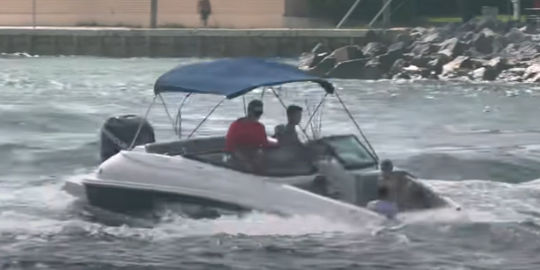Bowriders, or boat types with open bows, are quite popular and marketable, especially to young families. The category includes modified runabouts, deck boats and ski/tow/wakeboard boats, among others. The reasons for their popularity are attractive:
- Room in the bow for extra passengers.
- Easy for boatbuilders to design and manufacture from existing closed bow types.
- The marketability of luxurious and comfortable lounge-type seating.
- The appeal of separating kids from adults.
However, the dangers that come with irresponsible or inexperienced operators are significant, especially with today’s high speed bowriders:
- Easy for passengers to fall overboard and be struck by the hull or the propeller.
- Forward visibility for the pilot is obstructed by occupants in the bow, heightening the risk of collisions or grounding.
- Added weight forward affects tracking, especially in waves or crossing wakes.
- Reduced freeboard forward when occupied, increases the danger of “stuffing” the bow and swamping.
- Danger of ejection and injury during collisions or sudden grounding.
- Danger of broaching in a following sea with passengers in the bow.
- Lack of PFD use and minimal, low-profile rails increases the risk of ejection and drowning.
Risk even at low speed

This type of bowrider ski boat was involved in a fatal accident when overloaded in the bow at a speed of only 10 mph when crossing its own wake.
The danger is amplified when rental bowriders are placed in the hands of inexperienced operators with large parties. Consider the conditions of a tragic death that occurred in 2014 at Lake Burton in Georgia. A 7-year-old boy lost his life while a passenger in a rented 20 ft., inboard-powered bowrider tow boat. He was one of a party of six; four of whom were children who were seated in the bow. The boat crossed its own wake at less than 10 mph. The bow stuffed under the wake, immediately swamping the boat. The boy was washed overboard; the pilot shifted the boat into reverse in an attempt to save the boat. The ejected boy became entangled and lodged in the propeller, rudder and driveshaft, where he died from drowning and massive blood loss.
Safety first
It is a common sight to see bowriders overloaded with too many occupants seated in the bow. The tragic incident shows that it does not require extreme conditions for death to result.

A good addition to a bowrider is a tonneau that can be quickly snapped in place when the weather deteriorates, converting a bowrider into a safer runabout configuration.
How can bowrider accidents be avoided? Here are some recommendations to share with skippers when the opportunity presents itself?
- Take a boating safety course.
- Read the capacity plate and never exceed weight and passenger limitations.
- Realize the legal responsibilities applying to anyone who operates a boat.
- Clear the bow area when navigating a following sea.
- Clear the bow area when operating at cruising speed or above to prevent obstructed vision.
- Require PFD use especially for bow passengers above no wake speed.
- Never overload the bow of the boat with passengers, even at what seems to be low speed.
- In the event of ejection, immediately shift to neutral and account for all passengers before maneuvering.
- Purchase a tonneau cover for the bowrider area to use when the weather gets dirty.
Do you have any observations or experience with the safety aspects of bowriders? Tell us about it in the Comments section.
Resource:
https://www.safetyresearch.net/blog/articles/litigation-pushes-ski-boat-manufacturers-safer-designs








If I did not read your article, I wouldn’t know that there are so many Bowrider risks. The notes you share to avoid accidents when using the Bowrider boat are very helpful. Thank you for sharing